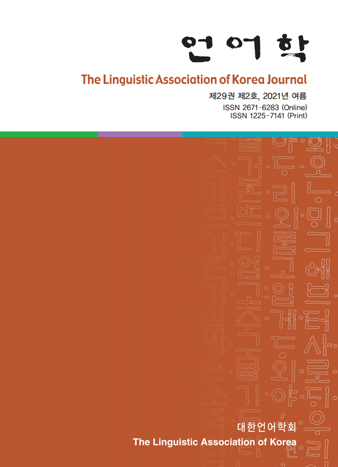대한언어학회 전자저널

29권 2호 (2021년 6월)
- 예체능계열 학습자들의 영어글쓰기와 피드백에 대한 인식
-
진송화
Pages : 115-141
Abstract
Jin, Songhwa. (2021). Perceptions of English writing and feedback from students majoring in arts and physical education. The Linguistic Association of Korea Journal, 29(2), 115-141. The purpose of this study was to find out the perceptions of English writing and feedback from college students majoring in arts and physical education. Students received feedback on their English writing three times: once from their teacher and twice from their peers. The students were asked to correct their writing after receiving the feedback. The findings were as follows: First, the learners were not interested and confident in English writing, but they recognized the need to write in English. Second, learners wanted to write English reports or resumes that would help them get a job in the future. Third, as the need for writing increased, learners showed different aspects in their preferences for the types of writing class activities. Finally, the learners recognized the importance of feedback from both their peers and their teacher. According to the survey, the learners answered that the teacher feedback was more helpful than the peer feedback.
Keywords
# 영어 글쓰기(English writing) # 대학영어(college English) # 피드백(feedback) # 인식(perceptions) # 예체능계열 전공(arts and physical education majors)
References
- 김명주. (2005). 기고: 대학 교양영어 개선 방향. 교수신문, 5월 15일 2005년, http://www.kyosu.net/news/articleView.html?idxno=7611
- 김연희. (2015). 교사 피드백과 동료 피드백이 학생들의 작문 수정과 향상에 미치는 영향 비교. 영어영문학 연구, 57(3), 59-79.
- 김영자. (2013). 교사/동료 피드백이 영어쓰기에 대한 학습자 인식에 미치는 영향: 쓰기 수준별 분석. 영어영문학, 18(1), 177-205.
- 김지나, 진송화. (2015). 초등 영재들을 위한 영어 글쓰기 지도와 효과적인 첨삭 방법에 대한 사례연구. 언어학, 23(3), 153-171.
- 김지은, 유호. (2014). 특수목적 영어(ESP)로서의 스포츠 영어교육: 스포츠관련 분야 학생들의 자기인식을 중심으로. 한국콘텐츠학회논문지, 14(11), 509-517.
- 김진희. (2016). 예술계열 대학생의 글쓰기 수업사례 연구: 작업일지를 중심으로. 교양교육연구, 10(4), 181-208.
- 문지순, 유성호. (2017). 예체능 계열 영어교육의 필요성과 효과에 대한 연구. 커뮤니케이션디자인연구, 60, 143-151.
- 민찬규, 김보경. (2006). 협동학습을 활용한 고등학교 영어 쓰기 지도 효과. 영어영문교육, 12(4), 186-210.
- 박미경. (2020). 소그룹 협력쓰기와 과정중심 피드백을 통한 교양영어 쓰기수업 방안 연구. 교양교육연구, 14(2), 159-174.
- 박부남. (2018). 예술대학 영어 학습모형 개발 기초연구: 요구분석과 학습동기를 중심으로. 열린교육연구, 26(3), 131-158.
- 박부남. (2020). 예술플랫폼을 활용한 예술영어 통합 수업 모형 개발과 적용. 열린교육연구, 28(2), 293-319.
- 박소은. (2013). 한국 학생들의 영작문 불안과 영작문 전략 사용 연구. 전주대학교 교육대학원 석사학위논문.
- 변지현. (2014). 영작문 수업에서 교사 피드백에 대한 학습자 인식 및 반응조사. 언어학연구, 19(6), 27-51.
- 성귀복. (2018). 모바일앱을 활용한 대학생들의 영문 동료피드백 활동 연구. 학습자중심교과교육 연구, 18(8), 539-570.
- 신영헌. (2018). 대학생의 영어 글쓰기 능력 향상을 위한 교양영어수업 연구. 교양교육연구, 12(4), 37-56.
- 원주연, 성귀복. (2017). 모바일 앱 기반의 영어 어휘 활동에 나타난 동료 피드백 양상 연구. 외국학연구, 39, 87-119.
- 이승은, 김경훈. (2018). 영어 쓰기 활동이 영어 능력향상에 미치는 효과와 쓰기 피드백에 대한 학습자들의 태도. 인문사회 21, 9(5)
- 이승은, 조욱상. (2019). 체육특기자 대학생을 위한 영어: 요구 분석과 변인들의 상관관계. 영어교과교육, 18(1), 117-141.
- 이지연. (2010). 한국 대학생들의 영작문 활동 시 나타나는 동료피드백의 양상 및 이에 대한 인식. 현대영어교육, 11(3), 134-161.
- 이희연, 노승철. (2013). 고급통계분석론: 이론과 실습. 경기도 고양: 문우사.
- 정양수. (2010). 사이버 캠퍼스 기반의 교양영어수업에 대한 만족도 및 개선방안 연구. 언어연구, 26(1), 149-174.
- 정양수. (2012). 영어쓰기 과정에서 제공되는 피드백의 유형과 제공방법에 대한 학습자의 요구 분석. 현대영미어문학, 30(1), 31-56.
- 정영철. (2014). 통합적 접근: 영거 글쓰기 수업에서의 피드백주기 방식에 대한 대학생들의 인식. 현대영미어문학, 32(1), 79-101.
- 조은형. (2018). 협동학습을 통한 영어 쓰기 활동이 학습자의 영작문 불안과 영어학습 간접 전략에 미치는 효과, 영어교과교육, 17(1), 127-146.
- 주미진. (2012). Rasch 측정 모형을 통해 직접 피드백, 간접 피드백이 한국 대학생 영어작문 향상에 미치는 영향 조사. 영어교육연구, 24(4), 277-295.
- 탁진영. (2012). 쓰기에 대한 의식도 및 쓰기 중심 교양영어 수업의 방법·만족도 조사: 영어 원어민 교수와 한국인 영어 비원어민 교수 수업을 중심으로. 영미어문학, 105, 323-249.
- 한학선. (2017). 문법기반 영어쓰기 수업을 위한 교수법과 학습자 변인에 대한 고찰. 교양교육연구, 11(5). 409-447.
- Brown, H. D. (1994). Teaching by principles: An interactive approach to language pedagogy (2nd ed.). Englewood Cliffs, NJ: Prentice Hall Regents.
- Byrne, D. (1988). Teaching writing skills. London: Longman.
- Chandler, J. (2003). The efficacy of various kinds of error feedback for improvement in the accuracy and fluency of L2 student writing. Journal of Second Langage Writing, 12, 267-296.
- Chang, C, F. (2012). Peer review via three modes in an EFL writing course. Computers and Composition, 29(1), 63-78.
- Chin, C.-S. (2007). EFL learners’perceptions on English writing tasks and teacher feedback. English Language & Literature Teaching, 13(1), 1-26.
- Ellis, R. (1985). Understanding second language acquisition. London: Oxford University Press.
- Hedgcock, J., & N. Lefkowitz. (1996). Some input on Input: Two Analyses of Student Response to Expert Feedback in L2 Writing. The Modern Language Journal, 80(3), 287-308.
- Munice, J. (2000). Using written teacher feedback in EFL composition classes. ELT Journal, 54(1), 47-53.
- Narciss, S. (2008). Feedback strategies for interactive learning tasks. In J. Spector, M. Merrill, J. van Merrienboer, & M. Driscoll (Eds.), Handbook of research on educational communications and technology (pp. 125-144). Mahaw, NJ: Lawrence Erlbaum Associates.
- Peterson, R. A. (1994). A meta-analysis of Cronbach’s alpha. The Journal of Comsumer Research, 21, 381-391.
- Saito, H. (1994). Teacher’s practices and students’s preferences for feedback on second language writing: A case study of adult ESL learners. TESL Canada Journal. 11(2), 46-70.
- Truscott, J., & Hsu, A. (2008). Error correction, revision, and learning. Journal of Second Language Writing, 17, 292-305.
- Tsui, A. B. M., & Ng, M. (2000). Does secondary L2 writers benefit from peer comments? Journal of Second Language Writing, 9(2), 147-170.
- Zamel, V. (1982). Writing: The process of discovering meaning. TESOL Quarterly, 16, 195-209.
- Zhu, W. (2001). Interaction and feedback in mixed peer response groups. Journal of Second Language Writing, 10, 251-276.